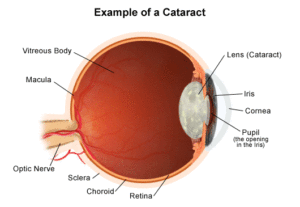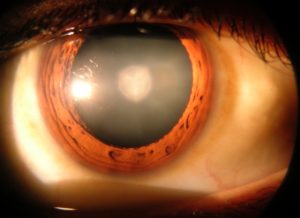What is a Cataract ?
Many people have Cataract, but they do not know what is cataract exactly. A cataract is a clouding of the lens in the eye that affects vision. A cataract is not a tumor or a growth that develops over the front surface of the eye. Most cataracts are not visible to the naked eye, but sometimes the pupil can appear white because the lens is completely clouded by a very dense cataract.
Cataracts are the most common cause of vision loss in people over age 40 and they are the principal cause of blindness in the world. Most cataracts are related to aging, but there are also cataracts caused by eye trauma or metabolic disorders like diabetes.
Cataracts are common as we age. In fact, they are so common that by the age of 80 years, more than half of all Americans have either had cataract surgery or have a cataract.
A cataract can occur in either or both eyes, but it is not contagious and cannot spread from one eye to the other. Cataracts often develop slowly with a gradual decline in vision. Glasses don’t help make the vision clearer. People often complain of having blurry vision, difficulty reading in dim light, poor vision at night, or glare and halos around lights. Some people complain of double vision.
A cataract can lead to blindness if it is not treated.
What Causes Cataracts?
The human eye is quite complicated and complex. At its most basic level, it acts sort of like a camera. So, in keeping with the camera analogy, let’s understand a bit about the eye and how a cataract affects vision.
The lens of the eye lies behind the iris and the pupil. Just like a camera lens, it focuses light onto a background. In the human eye, the lens focuses light onto the retina at the back of the eye, where an image is recorded and sent by the optic nerve to the brain. The lens also adjusts the eye’s focus, like the aperture of a camera, letting us see things clearly both up close and far away. Our lens is made of mostly water and protein. This protein is designed to specifically keep the lens clear and let light pass through it.
But as we age, some of the protein may clump together and start to cloud the lens. This clouded area is referred to as a cataract. Gradually, over time, the cataract grows larger and clouds more of the lens, making it harder and harder to see.
Although everyone develops cataracts as they age, certain things make a person more susceptible to cataracts. Genetics, UV radiation from unprotected eye exposure to the sun, and diseases like diabetes, play a part, as do smoking and excessive alcohol. Basically, these are inflammatory factors that cause the protein in the lens to experience “wear and tear” over the years.
Early Signs of Cataracts
There are many signs that a cataract is developing. Some of these visual effects could be caused by other eye problems, so go to your eye doctor as soon as you notice anything amiss with your vision.
A cataract is a clouding of the lens in the eye that affects vision. This clouding develops slowly and doesn’t initially impact vision, even though it actually affects eyesight. Examples of affected vision include the need for more light to see well, or the need for reading glasses around age 40, or glare driving at night or in certain weather conditions.
Initially these symptoms are tolerable and one can adapt, as changes tend to occur gradually. However, the cataract will eventually affect the vision so much that it will impact daily life.
The most common symptoms of a cataract are:
• Cloudy or blurry vision
• Colors seem faded and less bold
• Inability to discern between certain colors
• Glare from car headlights, lamps, or sunlight may appear too bright
• A halo may appear around lights
• Poor night vision
• Double vision or multiple images in one eye
• Frequent changes in eyeglass or contact lens prescription
Some of these symptoms can also be a sign of other eye problems. If you have any of these symptoms, check with your eye care professional.
Cataracts: You Don’t Have to Live with Them
The only treatment for cataracts is surgery. There are multiple intraocular implants to choose from: standard (covered by insurance) or multifocal. You can also choose a toric lens, which is designed in such a way that it can be used to correct astigmatisms and nearsightedness or. You and your surgeon can design a lens specifically to designed to accommodate your sight needs. Cataract surgery is the most commonly performed surgical procedure in the world – and fortunately, among the most successful.


